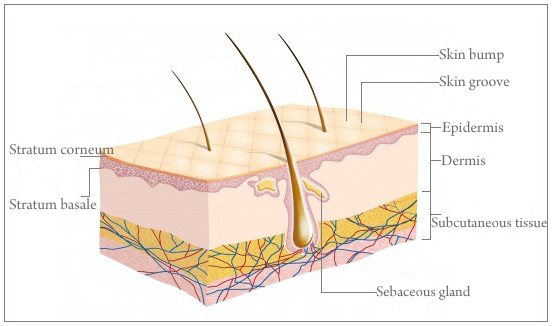Services

Services
.jpg)
Good maintenance and skincare are everyone’s dream come true. Knowledge of your own skin type and choosing skincare products that are suitable for you can help you get by the crisis of quick skin aging. It is only through proper protection and care can you put a stop to skin damage and achieve synergetic results. Skincare is not about dependence over cosmetics. With proper long-term skincare, the skin’s youthful resistance can be restored.

♦Structure of Skin.jpg)
The skin can be divided into three parts: epidermis, dermis, and subcutaneous tissue. The epidermis is a type of tissue with boosted metabolism, as new epidermal cells continue to replace old ones every day. From up to bottom, it consists of five layers: strategy basale, strategy spinosum, stratum granulosum, stratum lucidum, and stratum corneum. The functions of these layers will determine whether or not the skin is healthy and beautiful. On the other hand, the dermal layer supplies nutrients to the skin and maintains its elasticity.Skin Bump, Skin Groove, Subcutaneous Tissue, Sebaceous Gland

The metabolic cycle of a normal skin surface is 28 days. Skincare is not only about obtaining immediate results. It is “maintenance” that matters; it is daily care that is important. Therefore procedures that emphasize speedy results are not recommended.
♦Epidermis :
Located in the upper most layer of the skin and measuring 0.02-0.03cm, its main function is to promote cell renewal, skin metabolism, and cell regeneration.
Epidermis:Stratum corneum、Stratum lucidum、Stratgum granulosum、Stratum spinosum、Stratum basale.
A.Stratum corneum:
1. The cells are prokaryotic, which naturally shed through metabolism. Under normal conditions, one metabolic cycle takes 21-28 days to complete, but the rate of metabolism decreases with age, sunlight exposure, and air pollution, sometimes even extending the metabolic cycle to 35-40 days.
2. Dead cells that do not shed naturally will result in the skin’s loss of radiance, making it appear coarse and affecting the skin metabolism. Cuticles are thick; therefore, manual removal (use of exfoliating cream for exfoliation and massage cream for promoting metabolism) is required to create smooth and delicate skin.
3. The skin texture, moisturization, translucency, and protection are generally determined by the stratum corneum.
◎The skin’s normal water content is 15%-25%.
◎If >30%→eczema, allergies, and itchiness are likely to result.
◎If<10%→The skin is likely to become dry, appear, dull, and peel, thus leading to fine lines, wrinkles, and aging.
B.Stratum lucidum:Found only in the palms and feet, it displays certain refractive and protective action against sunlight.
C.Stratgum granulosum:Made up of clear and minute granular cells, the cells are dying and are about to be transformed into the stratum corneum.
D.Stratum spinosum:This layer with lymph flow plays the role of supplementing nutrients.
F.Stratum basale:There is an array of cells, mitosis, and intracellular inclusions of “melanin pigments” (commonly known as melanin). Sun exposure will accelerate division, resulting in increased melanin. People with boosted metabolism can metabolize the melanin; people that have slower metabolism will form dark spots due to hyperpigmentation in the skin. Therefore, the sunscreen ingredients in skincare products are extremely important.
.png)
♦Dermis:
It is the middle layer of the skin, which is subdivided into three layers.。
A.Papillary layer:There are many blood vessels that supply nutrients to the basal layer to facilitate smooth basal cell division.
B.Subpapillary layer:With rich moisture, the skin appears tender (this layer contains hyaluronic acid).。
C.Reticular layer:It secretes two precious nutrients the skin needs, including collagen and elastin.
1. Collagen: It can provide skin support and plays the role of tissue repair.
2. Elastin: The secretion of these two nutrients diminishes with age and sun exposure.
♦Subcutaneous Tissue:
Made up of fat globules, the thickness varies with age, gender, and the health condition of individuals.

♦Classification of Skin Types.jpg)
|
Neutral skin |
Non-greasy, moisturized (less sebum, more water) |
|
Dry skin |
Dry skin surface (inadequate sebum and water) |
|
Oily skin |
Larger and more oily pores (more sebum and water) |
|
Mixed skin |
Oily and dry (more sebum, inadequate water) |
|
Sensitive skin |
More sensitive to external stimuli |
♦Moisturizing methods for different skin types are as follows:.jpg)
|
Neutral skin |
Use moisturizing lotion after dampening the skin in order to retain water. Oil-based cream is not recommended to avoid blocking the pores. |
|
Dry skin |
After dampening the skin, supplement oil-based cream to maintain the function of the sebum film and reduce evaporation. |
|
Oily skin |
With proper cleansing, only a suitable amount of convergent/moisturizing toner is needed. Unless otherwise dry, moisturizing lotion is not needed. |
|
Mixed skin |
Apply a suitable amount of convergent/moisturizing toner on the T-area; supplement oil-based cream applied on both cheeks. |
|
Sensitive skin |
After moisturizing the skin, strengthen the use of moisture-factor skincare products to repair damaged and delicate skin. |